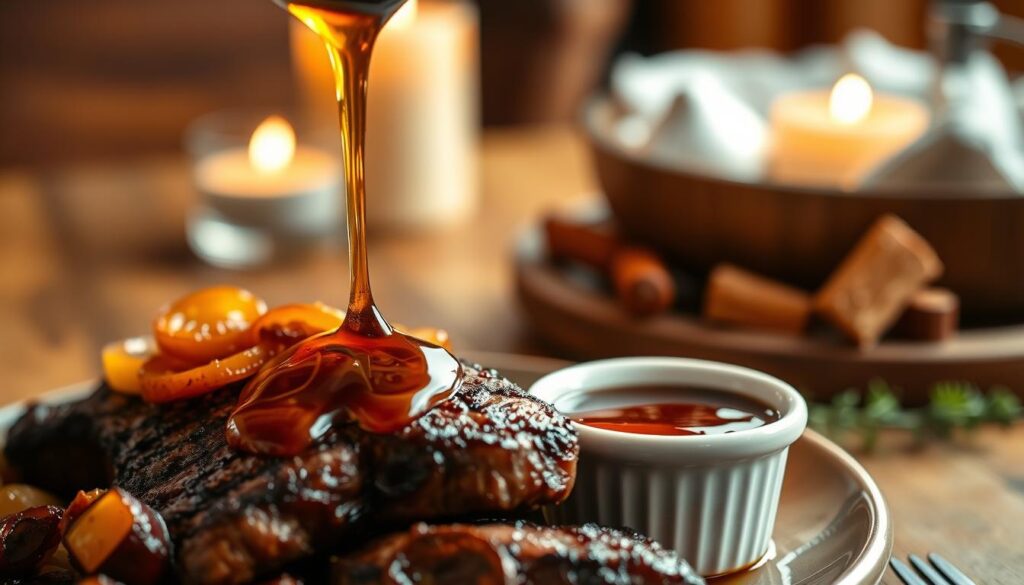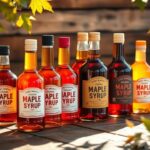Maple syrup is more than just a breakfast staple. It’s a versatile ingredient that adds depth to savory dishes. Chefs and home cooks use it to enhance roasted veggies and grilled meats. It brings a sophisticated sweetness that pairs well with strong flavors.
The culinary world loves maple syrup in Savory Recipes. It adds complexity to many dishes. Its caramel-like taste and hint of woodiness make it perfect for marinades, glazes, and sauces.
Chefs and home cooks are exploring new ways to use maple syrup. They’re creating dishes that amaze and delight. Think maple-glazed salmon or maple-infused BBQ sauces. The options are endless.
This guide will show you how to use maple syrup in Savory Recipes. You’ll learn new cooking techniques and flavor combinations. Get ready to change your cooking style and discover maple syrup’s amazing uses beyond breakfast.
Understanding the Versatility of Maple Syrup in Cooking
Maple syrup is more than just a breakfast sweetener. It’s a key ingredient in savory dishes. Chefs and home cooks are finding out how maple syrup adds depth and complexity to food, making it special.
Maple syrup offers a wide range of flavors and uses. The right syrup can make simple dishes into something amazing. It’s perfect for Maple Glazed Vegetables and more.
Types of Maple Syrup for Cooking
Maple syrup has different grades, each with its own taste:
- Golden Color, Delicate Taste: Great for light glazes and dressings
- Amber Color, Rich Taste: Best for roasting and marinades
- Dark Color, Robust Taste: Ideal for dishes needing strong flavors
Pure vs. Artificial Maple Syrup
Real maple syrup is a big difference from artificial. Pure maple syrup gives:
- True, complex flavors
- Natural health benefits
- No added sugars or corn syrup
Storage and Shelf Life Tips
Keep your maple syrup fresh by storing it right. Unopened bottles last up to two years in a cool, dark spot. Once opened, keep it in the fridge to keep its flavor and prevent crystals.
Professional chefs suggest buying small amounts for the best taste in your Maple Syrup in Savory Recipes.
The Science Behind Maple Syrup in Savory Dishes
Maple syrup does more than just sweeten dishes. Its complex makeup turns simple meals into works of art. Knowing how maple syrup works in cooking shows why it’s key in kitchens.
Maple syrup’s unique structure changes how flavors mix. Its mix of sugars, minerals, and compounds creates new tastes. This makes savory dishes taste richer and more complex.
Chemical Composition Breakdown
| Compound | Flavor Impact | Culinary Function |
|---|---|---|
| Sucrose | Sweet Base | Caramelization Catalyst |
| Minerals | Earthy Undertones | Flavor Depth Enhancement |
| Amino Acids | Umami Complexity | Maillard Reaction Trigger |
The Maillard reaction is key to maple syrup’s magic. When maple syrup meets proteins at high heat, it starts browning reactions. This turns simple ingredients into gourmet dishes.
- Triggers complex flavor development
- Produces rich caramelized notes
- Enhances protein and vegetable dishes
Maple syrup isn’t just sweet—it’s a sophisticated culinary catalyst that transforms cooking through complex chemical interactions.
Professional chefs use maple syrup’s science to create deep flavors. By understanding these principles, home cooks can make their dishes stand out.
Essential Tips for Cooking with Maple Syrup
Maple syrup is more than just a breakfast sweetener. It’s a versatile ingredient that can make both sweet and savory dishes better. Knowing how to use it can help you make amazing Maple Roasted Meats and tasty Maple Balsamic Vinaigrette.
Cooking with maple syrup needs attention to detail and technique. Both professional chefs and home cooks have found it can really improve flavors in many recipes.
Temperature Control Techniques
Getting the temperature right is key when using maple syrup. High heat can burn it and make it taste bitter. So, use low to medium heat for most recipes.
- Start with low to medium heat settings
- Use a digital thermometer for precise monitoring
- Remove from heat when syrup begins to caramelize
- Allow residual heat to complete the glazing process
Substitution Guidelines
Maple syrup can replace other sweeteners in recipes, but knowing the right amounts is important. This keeps the dish balanced.
- Replace sugar with maple syrup using a 1:1 ratio
- Reduce liquid ingredients by 1/4 cup for every cup of syrup
- Choose grade A light amber for delicate dishes
- Select darker grades for robust flavor profiles
Balancing Sweet and Savory Flavors
Using maple syrup in dishes means knowing how it works with savory flavors. Maple Roasted Meats need the right seasoning to match the syrup’s sweetness.
The key is to treat maple syrup as a nuanced ingredient, not just a simple sweetener.
For Maple Balsamic Vinaigrette, mix maple syrup with tangy balsamic vinegar and herbs. This makes a dressing that’s great for salads and marinades. Start with a little syrup and adjust to taste, letting its flavor stand out.
Maple Syrup in Savory Recipes: A Guide

Maple syrup can turn simple dishes into amazing meals. It’s not just for breakfast anymore. It adds a special flavor to many savory dishes.
Maple syrup opens up new flavors in cooking. Chefs and home cooks are finding new uses for it. It’s great in main courses, marinades, and glazes.
- Roasted vegetable glazes
- Meat marinades
- Salad dressing foundations
- Sauce reductions
Knowing how to use maple syrup is key. Different syrups have different strengths. Light amber syrup is good for light dishes. Darker syrups are better for bold flavors.
Experts say to try maple syrup instead of sugar in savory dishes. It adds a unique taste that makes food memorable.
“Maple syrup is not just a breakfast condiment – it’s a sophisticated ingredient that can transform any savory dish.” – Professional Chef Michael Roberts
Maple syrup is great for many dishes, from Asian glazes to Mediterranean sauces. It lets cooks be creative and try new things.
Creating Perfect Maple Glazed Vegetables
Maple syrup makes ordinary vegetables into something special. It adds a sweet and caramelized touch that makes simple veggies taste like gourmet dishes.
Choosing the right veggies is key for maple roasted sweet potatoes and other glazed dishes. Root veggies pair well with maple syrup’s unique taste.
Best Vegetables for Maple Glazing
- Sweet potatoes
- Carrots
- Parsnips
- Brussels sprouts
- Butternut squash
Roasting Techniques and Times
To get perfect maple glazed veggies, you need to know about temperature and timing. The right roasting turns veggies into sweet, flavorful treats.
| Vegetable | Temperature | Roasting Time | Maple Glaze Technique |
|---|---|---|---|
| Sweet Potatoes | 425°F | 25-30 minutes | Brush with pure maple syrup halfway |
| Carrots | 400°F | 20-25 minutes | Drizzle maple syrup last 10 minutes |
| Brussels Sprouts | 425°F | 20-25 minutes | Toss with maple syrup before roasting |
Tip for maple roasted sweet potatoes: Cut veggies the same size for even caramelization. The goal is to make a glaze that boosts the veggie’s flavor without overpowering it.
Maple Roasted Meats and Poultry

Maple roasted meats turn simple dishes into amazing meals. Maple syrup’s sweetness makes chicken, pork, and beef taste incredible. It adds a special caramelization that boosts their flavors.
Choosing the right maple syrup is key for great maple roasted meats. Dark amber syrup has the strongest flavor. It makes glazes that soak into the meat, making it taste even better.
- Chicken: Best roasted at 375°F with maple-herb glaze
- Pork: Ideal internal temperature of 145°F
- Beef: Use medium-high heat for optimal caramelization
Experts say to baste meats with maple syrup every 15-20 minutes. This method ensures they get full flavor. It also makes the outside golden and keeps the inside juicy.
The secret to perfect maple roasted meats lies in balancing sweet and savory elements.
Marinating proteins for 2-4 hours before roasting lets maple syrup soak into the meat. Try different maple syrup grades to find flavors you love.
Salt and herbs are important for maple roasted meats. Rosemary, thyme, and sage pair well with maple’s sweetness. They create rich flavors that excite your taste buds.
Crafting Maple-Based Marinades and Sauces
Maple syrup makes marinades and sauces special. Both chefs and home cooks love its unique taste. It adds depth and complexity to many dishes.
To make tasty maple-based marinades, you need to know about flavor balance. Maple syrup’s sweetness is perfect for creating rich sauces. These sauces go well with many proteins and vegetables.
Maple Soy Marinade Variations
A Maple Soy Marinade is great for many cooking styles. It includes:
- Pure maple syrup
- High-quality soy sauce
- Minced garlic
- Fresh ginger
- Sesame oil
This marinade is perfect for chicken, salmon, and tofu. You can marinate for 30 minutes to 4 hours. It depends on the protein and how strong you want the flavor.
Classic Maple Balsamic Vinaigrette
The Maple Balsamic Vinaigrette is a mix of sweet and tangy. It’s great for salads, roasted veggies, and grilled meats. It adds a sophisticated touch.
To make a top-notch Maple Balsamic Vinaigrette, mix:
- Extra virgin olive oil
- Aged balsamic vinegar
- Pure maple syrup
- Dijon mustard
- Minced shallots
Whisk until smooth. This creates a dressing that highlights maple syrup’s amazing taste.
Maple Mustard Glazes for Proteins
Maple mustard glaze turns simple proteins into amazing dishes. It mixes the sweetness of maple syrup with mustard’s tanginess. This combo makes chicken, pork, and fish taste better.

Making the best maple mustard glaze is all about finding the right mix of sweet and savory. The type of mustard you use can change the glaze’s taste a lot:
- Dijon mustard gives a sharp, fancy flavor
- Whole grain mustard adds a fun texture
- Honey mustard is sweeter and milder
Top chefs say to use the best maple syrup for a real maple mustard glaze. Grade A dark color maple syrup has the strongest taste for meat.
“The secret to an incredible maple mustard glaze is balancing sweetness with acidity” – Professional Chef
How you prepare your protein matters a lot. Good marinating and cooking help the glaze stick and caramelize better.
| Protein Type | Recommended Glaze Technique | Cooking Temperature |
|---|---|---|
| Chicken Breasts | Brush during last 10 minutes | 375°F |
| Pork Tenderloin | Marinate 2-4 hours | 400°F |
| Salmon | Glaze before final 5 minutes | 425°F |
Trying out maple mustard glaze can open up new flavors in your protein dishes. It’s a fun way to get creative in the kitchen.
Perfecting Maple Bacon Brussels Sprouts
Maple Bacon Brussels Sprouts is a culinary masterpiece. It turns simple veggies into a side dish that’s truly special. The mix of Brussels sprouts, bacon, and maple syrup is a match made in heaven.
To make the perfect Maple Bacon Brussels Sprouts, you need to focus on a few things. It’s all about getting the right balance of caramelization, crispiness, and flavor.
Preparation Methods
Getting Maple Bacon Brussels Sprouts ready involves a few important steps:
- Choose fresh, firm Brussels sprouts with tight, green leaves
- Trim the ends and halve the sprouts for maximum surface area
- Pat the sprouts completely dry to ensure proper roasting
- Cut bacon into small, uniform pieces for even cooking
Seasoning Combinations
The right seasoning can take Maple Bacon Brussels Sprouts to the next level. Here are some great flavor combinations:
- Classic blend: Kosher salt, black pepper, and a touch of garlic powder
- Spicy variation: Red pepper flakes and smoked paprika
- Herb-infused: Fresh thyme and rosemary
Roasting the Brussels sprouts at high heat (around 425°F) helps them caramelize. The bacon gets crispy. Drizzle pure maple syrup during the last few minutes to add a sweet-savory glaze.
Maple Pecan Crusted Salmon Techniques
Making Maple Pecan Crusted Salmon is all about precision and knowing how flavors work together. This dish turns a simple salmon fillet into a gourmet delight. It’s a mix of sweet, nutty, and savory tastes.
To make a great maple pecan crust, you need to follow some important steps:
- Choose fresh, high-quality salmon fillets with little skin
- Go for pure maple syrup for real flavor
- Toast pecans to bring out their nutty taste
- Make sure the crust coats evenly for a crunchy texture
The key to a fantastic Maple Pecan Crusted Salmon is in how you prepare it. Begin by drying the salmon to help the crust stick well. Crush the pecans finely so they cook evenly and get crispy.
Here are the ingredients you’ll need for the maple pecan crust:
- Finely chopped pecans
- Pure maple syrup
- Dijon mustard
- Fresh thyme
- Panko breadcrumbs
When cooking Maple Pecan Crusted Salmon, temperature is critical. Bake at 400°F for 12-15 minutes. This ensures the fish stays moist and the crust gets golden and crispy.
Pro tip: Let the salmon rest for 2-3 minutes after cooking. This helps the juices spread, making the salmon tender and flavorful.
Asian-Inspired Maple Syrup Dishes
Maple syrup is more than just for breakfast. It’s a key ingredient in Asian-inspired dishes. Its natural sweetness and complex flavors match the bold tastes of Asian cuisine.
Creating amazing Asian dishes means knowing how maple syrup can change recipes. The Maple Soy Marinade is a great example. It mixes sweet and savory perfectly.
Fusion Recipes and Applications
Chefs are finding new ways to use maple syrup in Asian dishes. Some cool methods include:
- Creating glazes for grilled proteins
- Developing complex Maple Soy Marinade variations
- Enhancing stir-fry sauce compositions
- Balancing spicy and sweet flavor profiles
Traditional Asian Ingredients Pairings
Maple syrup pairs well with classic Asian ingredients. These pairings bring out amazing flavors:
| Ingredient | Maple Syrup Pairing Technique | Flavor Profile |
|---|---|---|
| Soy Sauce | Maple Soy Marinade | Umami-sweet balance |
| Ginger | Candied or infused | Spicy-sweet complexity |
| Sesame Oil | Glazing technique | Nutty undertones |
Trying maple syrup in Asian cooking is a creative journey. It’s all about understanding how ingredients work together and keeping flavors balanced.
Mediterranean Dishes with Maple Syrup
Maple syrup adds a unique sweetness to Mediterranean dishes. It brings a depth of flavor that chefs love. They’re finding new ways to use it in traditional cooking.
Mediterranean cooking is all about fresh ingredients and bold flavors. Maple syrup brings a surprising twist to classic dishes. It creates new and exciting flavors that food lovers enjoy.
- Maple-infused Greek salad dressings
- Roasted vegetable glazes
- Grilled meat marinades
- Olive oil and maple syrup combinations
Maple syrup’s rich flavor goes well with Mediterranean ingredients like tomatoes and herbs. Chefs are using maple syrup in savory recipes to create unique dishes.
| Mediterranean Dish | Maple Syrup Application | Flavor Profile |
|---|---|---|
| Roasted Eggplant | Maple Glaze | Sweet and Smoky |
| Grilled Lamb | Maple Marinade | Rich and Caramelized |
| Mediterranean Salad | Maple Vinaigrette | Tangy and Sweet |
Using maple syrup in savory recipes is a creative twist on Mediterranean cooking. It balances sweet and savory, making traditional dishes even better.
Maple syrup isn’t just for pancakes – it’s a global culinary adventure waiting to be explored!
Common Mistakes to Avoid When Cooking with Maple Syrup
Maple syrup can make simple dishes taste amazing. But, cooking with it can be tricky. Knowing the common mistakes helps you avoid them and get great results.
Using maple syrup in cooking needs precision. Both chefs and home cooks face challenges. They must avoid mistakes to make their dishes stand out.
Temperature Control Challenges
Maple syrup is very sensitive to heat. High temperatures can change its flavor and performance. It can:
- Burn quickly, creating bitter undertones
- Caramelize too rapidly, disrupting intended flavor profiles
- Lose its nuanced sweetness
Ingredient Compatibility Considerations
Not every ingredient goes well with maple syrup. Knowing which ones work best is key. This helps you mix them right.
| Ingredient Group | Compatibility | Recommended Approach |
|---|---|---|
| Acidic Ingredients | Moderate | Balance with careful measurement |
| Proteins | High | Use as glaze or marinade |
| Vegetables | Excellent | Roast or caramelize with minimal added sugar |
Experts suggest starting with a little maple syrup. Adding it gradually helps control the flavor and prevents overpowering the dish.
Conclusion
Maple syrup is more than just for breakfast. It’s a key ingredient in savory cooking, adding depth and flavor to dishes worldwide. It makes roasted veggies and marinades taste amazing, opening up new ways to cook at home.
Using maple syrup in savory dishes is an art. It’s not just for sweetening. Chefs use it to balance flavors and create unique tastes. It’s great for glazing meats, making sauces, and adding to international recipes.
Maple syrup in savory recipes is a game-changer. It’s a natural sweetener that adds complexity to dishes. By trying out new recipes, you can make your meals stand out. It’s a chance to bring professional flair to your cooking.
Exploring maple syrup in savory cooking is exciting. It’s all about being creative and trying new things. Each dish is a chance to discover new flavors and celebrate cooking traditions.



